Thurso Surf Waterwalker 120
Pros
- A really nicely scaled down all-rounder, perfect for smaller / lighter beginners and intermediates.
- Easy to paddle and a whole lot of fun to throw around!
- The construction upgrades and thinner profile have considerably improved the performance and feel of the board
- The design delivers a surprisingly good amount of stability for such a small board.
- How great it is to see a really well configured smaller board that offers a really good set of fittings.
- We love the bright, cheerful color schemes
- Great to be able to select the accessory components you need at check out.
Cons
- We’d love to see Thurso Surf move the side fins out towards the rail, for surfing performance
- As it’s a board for smaller people, we’d like to see an option to bundle with some lighter paddle options as well as the Hybrid Carbon.
Thurso Surf’s smallest Waterwalker has been updated for 2025 with reduced thickness and improved construction. Our team checks out the changes.

We have been big fans of the Thurso Waterwalker 120, because it’s great to see a well-designed, well-configured all-around board designed specifically for smaller people. So we were really pleased to see that not only have Thurso continued it for another season, but they’ve also made a couple of fairly major tweaks, which hopefully should upgrade the performance without changing the essential character of the board. The rail construction has been changed for 2025 but more significantly, it is now manufactured in 4.7” thickness, so we were super keen to check out this thinner version. In this review we’ll tell you all about what we found, but without giving too much away too early, we can confirm that Thurso have definitely done some great things with this revamp.
We think the Thurso Surf Waterwalker 120 would be a great SUP for:
- Smaller paddlers wanting an appropriately sized first time board
- Smaller paddlers wanting a great all round board with an excellent set of features and fittings
- Small/medium sized paddlers wanting a board that feels small, lively and fun.
Thurso Surf Waterwalker 120: Spec Sheet
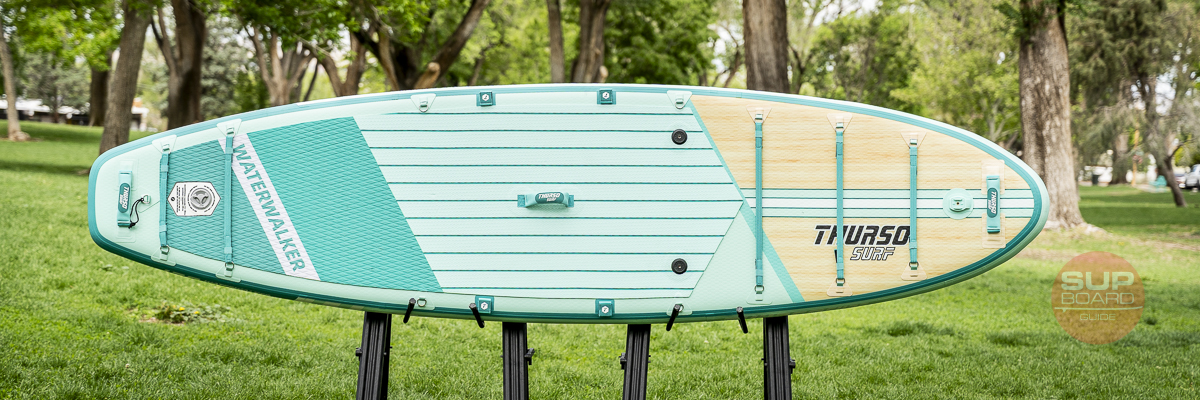
- Board Category: All round
- Listed Board Dimensions: 10’ x 30” x 4.7”
- Measured Board Dimensions: 10′ x 30.75 x 5”
- Listed Board Weight: 22.5 lbs
- Actual Board Weight (board only, inflated): 18.5 lbs
- Manufacturer’s Recommended Capacity: 100-150 lbs
- Recommended PSI: 12-15 (max 20)
- Fins: Flexi 9” dolphin center fin, plus 2 side fins.
- Paddle: 3-piece carbon nylon (as an upgrade option)
- Board Shell Construction: double layer fusion, welded rails
- Drop-stitch type: X-Woven
- Price Range: Low to Mid depending on options
- Warranty: 30 day full refund, 2 year full warranty (with conditions)
Performance Review of the Thurso Surf Waterwalker 120 Stand Up Paddle Board
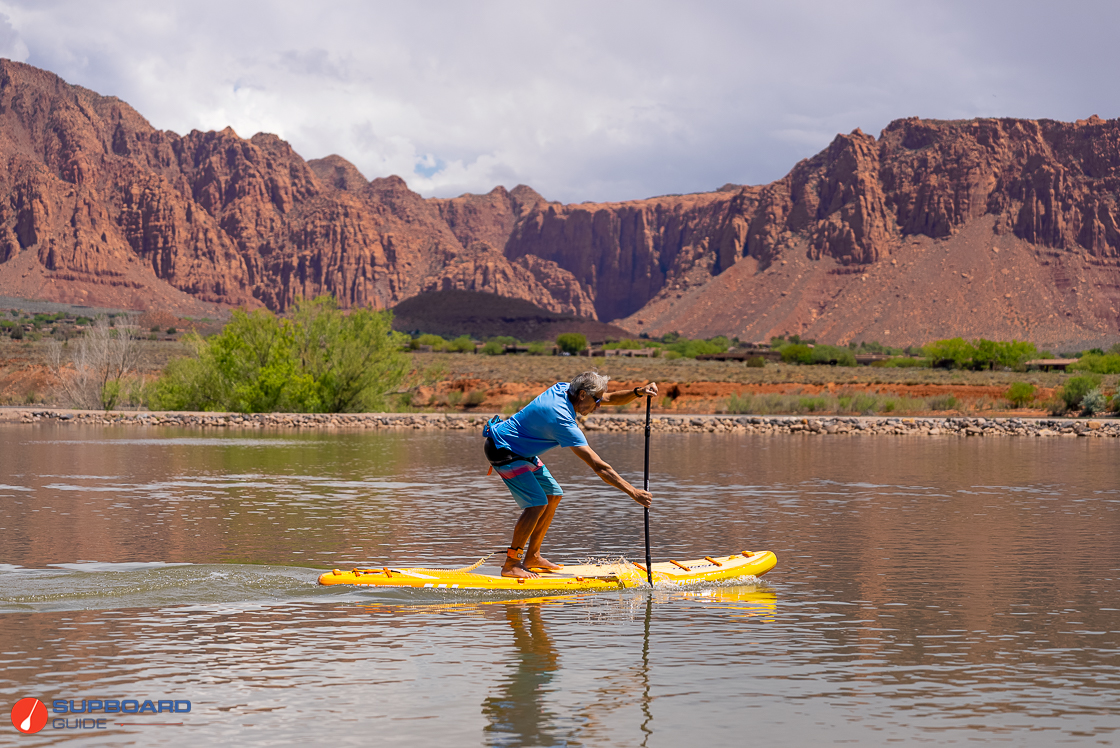
We really like the whole concept of Thurso’s Waterwalker range. The Waterwalker 120 is the smallest member of a family of three essentially identical boards, just scaled up slightly so that the buyer can choose the size best suited to their needs. The size increments are extremely logical and easy to understand; this board is 10’ x 30”, the next size up is the Waterwalker 126 which is 10’6 x 31”, and the biggest is the 11’ x 32”. These are all classic all-around board sizes.
So, being the smallest Waterwalker in the Thurso range, does the Waterwalker 120 feel like the ‘runt of the litter’; the unwanted baby in the family? Not a bit of it. Indeed, the reality is quite the opposite. Sadly, there really aren’t very many good options in this size and style of board. Most brands start their range with longer and wider designs, simply because it’s actually quite technically demanding to make a 10’ x 30” board that still retains enough rigidity and performance to be a quality product. Which means therefore, that paddlers of under around 160 lbs are not well served by the market. Often the only size-appropriate offering in a brand range is a “kids board” which is usually built to a lower quality and offering much less in terms of fittings and fixtures.
It’s not just smaller people who benefit from a smaller board, either. Many more experienced paddlers would love to have a go in the surf, but for this you absolutely need a smaller SUP. It’s a big jump down to a surf-sized SUP from your typical beginner board, so getting comfortable on a slightly smaller general purpose board before making that big step down to a surf-specific design is a great way of smoothing out that learning curve.
OK, so now we’ve set the scene, let’s get into the review. What were we going to find with this thinner version of the Waterwalker 120 – would it work, or have Thurso pushed their luck too far?
Overall Score: [9.5/10]
- Stability: 7.4/10
- Speed: 5.8/10
- Tracking: 8.7/10
- Maneuverability: 9.6/10
- Construction Quality: 9.5/10
- Features/Accessories: 9.4/10
Stability Rating: [7.4/10]
The stability score shown here is a global rating, based on comparative performance to all other sizes and styles of paddleboards (other than multi-person boards).
To understand our stability score for the Thurso Surf Waterwalker 120 we need to explain what we’re actually talking about here. There are two ways of looking at stability. Global, where we compare all boards to each other and rate them in order of absolute stability, and comparative, where we look at how a board compares to other boards of generally similar dimensions. The score above is that global rating, and for sure, in comparison to wider boards such as the other Waterwalkers, or more dramatically, the 34” wide Thurso Surf Max 11’6, there is a massive difference. A heavier rider who would be absolutely fine paddling around on the Max simply will not even be able to stand up on this board. Hence what may seem to be a relatively low score in this absolute rating.
However, when it comes to comparing the Waterwalker 120 to other boards of a similar general size, then it actually scores pretty well. The plan shape has been well engineered to maximise the stability that the board can offer. The wide square tail and the extra width up front give a lot of secondary stability and make the board feel safe and well balanced underfoot.
The reduced thickness has also played a positive role in improving the stability. It’s amazing what a positive difference it makes, particularly in rougher conditions.
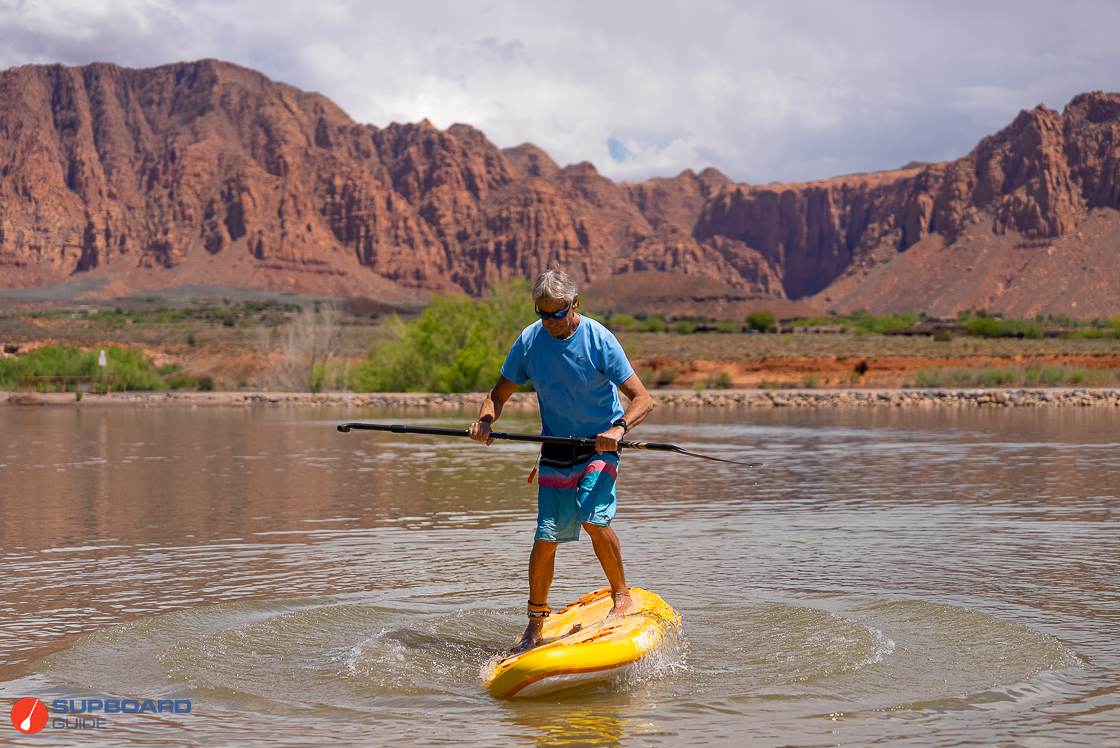
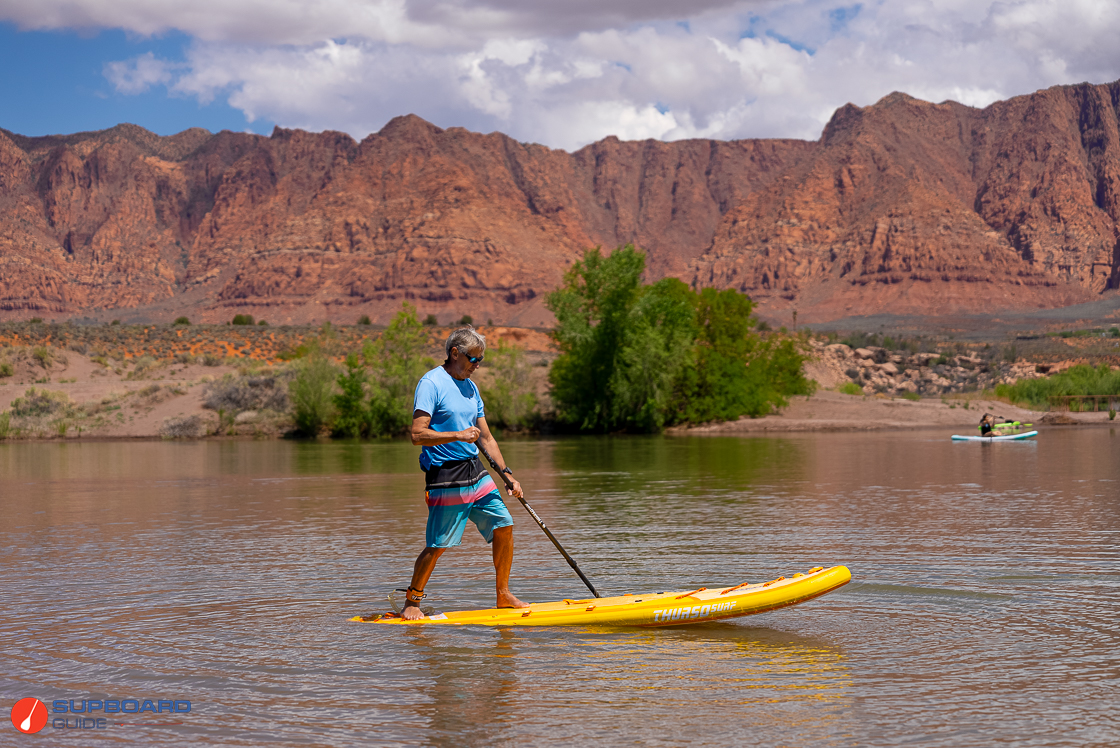
Thurso Surf suggests an ideal rider weight range for the board of between 100-150 lbs, and for newcomers to SUP looking for their first board we’d say that this is extremely realistic. However, if you’re already a reasonably experienced paddler and have decent balance, then the board can actually cope just fine with a lot more rider weight. Our 180 lb reviewer had no problem at all on the board, and even our 220 lb reviewer was perfectly capable of paddling it. But that’s because both these reviewers are extremely experienced and used to paddling small boards. This is something that comes with time and practice.
The point is that if you do weigh in above that 150 lbs suggested limit, it comes down to experience. If you’re new to paddling then you absolutely should not make the mistake of buying a board like this on the basis that “you will grow into it”. But if you are already a reasonably experienced paddler looking for something smaller, then this board will work really well for you.
Speed Test: 5.8/10
The speed score given above is a comparative rating to other sizes and styles of paddleboards, whereby 14’ raceboards would be scoring in the high 9s, and the widest all-round boards or surf-orientated shorter boards would be in the 5s or below.
Over the many years that we have been reviewing paddleboards at supboardguide.com, we have experimented with numerous different methodologies for speed testing, involving various hardware and software solutions. However, none have proved replicable; even using the same rider in the same conditions the numbers would vary from day to day, and of course when using different riders, or even just a different paddle, the results would change significantly. For this reason, while we still test all boards in cruise mode, fast cruise mode and then push them as hard as we can, we no longer give ‘absolute’ speed data (ie 5.5mph etc) – which ultimately doesn’t really matter unless you’re specifically looking to compete – and now report more on the general feel of the board when asked to perform.
Length is one of the primary parameters when it comes to boardspeed. Longer = faster, shorter = slower. So we’re not expecting amazing speed performance from any 10’ board, however well designed it may be. But speed is also a product of how easily a board can be paddled, and this is very much affected by the plan-shape and design, as well as the stiffness.
Cruising
Fast Cruising
Going Hard
We should add that these issues will be less apparent to a lighter rider. If you’re at the lower end of the suggested weight range for the Waterwalker 120, you will be putting much less load on the board when you’re looking for higher speeds, and it will cope somewhat better. Nevertheless, it is not by nature a speedy machine.
Overall
The Thurso Surf Waterwalker 120 has reasonable pace in cruise mode, and you can push it a bit harder if you need to, but sustaining higher speeds really isn’t what this board is about. Indeed, there aren’t really any paddleboards on the market of this length that are designed for speed, other than a couple of super-skinny junior raceboards that are unstable even for a tiny 100 lb rider! If you specifically want a faster board you’ll need to go longer; check out the Thurso Surf Expedition 138 or the Expedition 150.
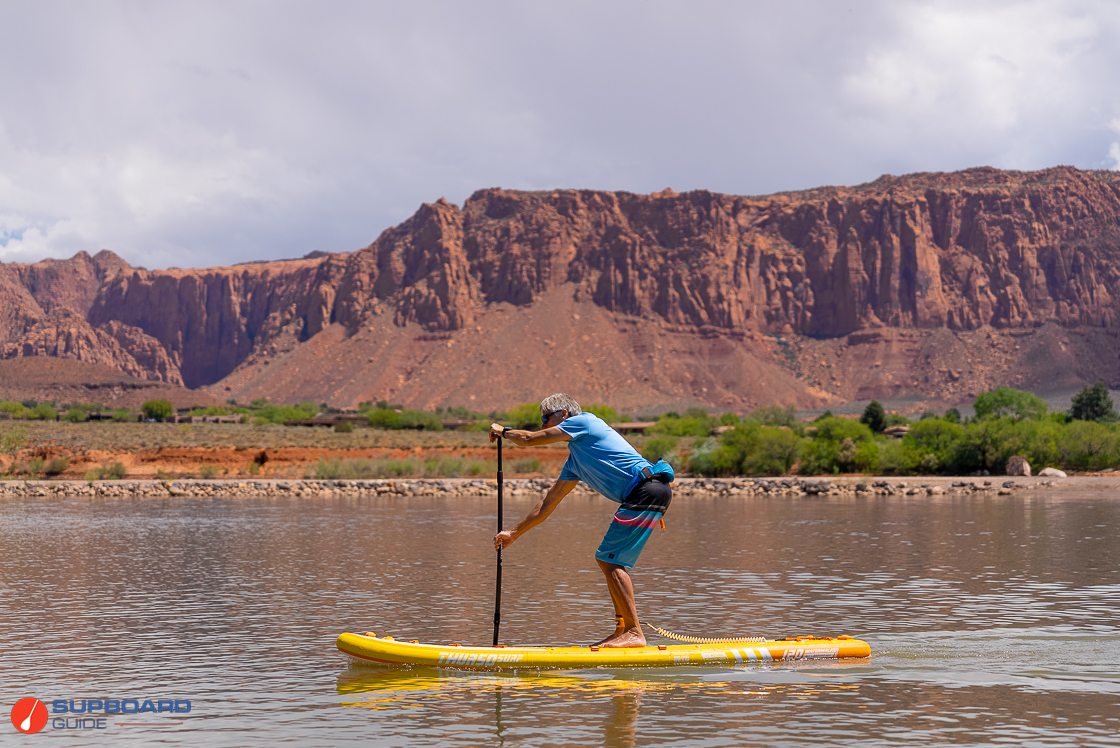
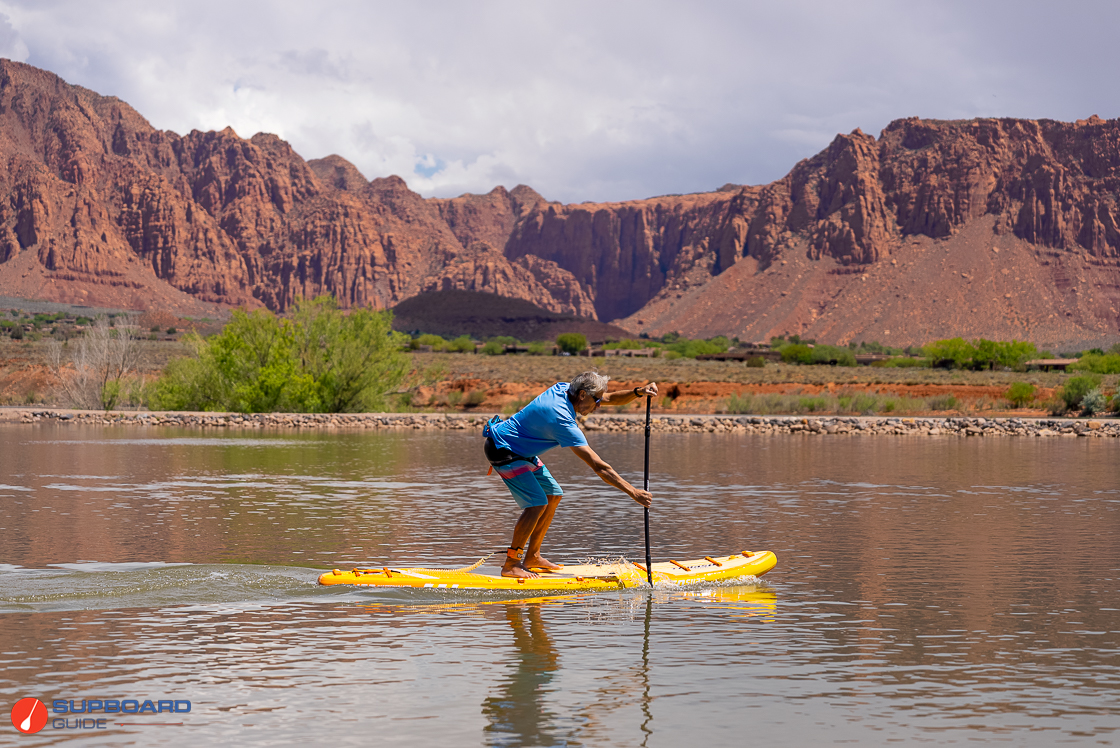
Tracking: 8.7/10
Tracking ultimately comes down to board length; a longer board will almost always track better than a shorter board of the same general width. So our tracking scores are intended to show how a board compares to other boards in its size. In the case of the Thurso Surf Waterwalker 120 the scores compare to other boards in the 10’0 – 11’6 all-purpose/touring category.
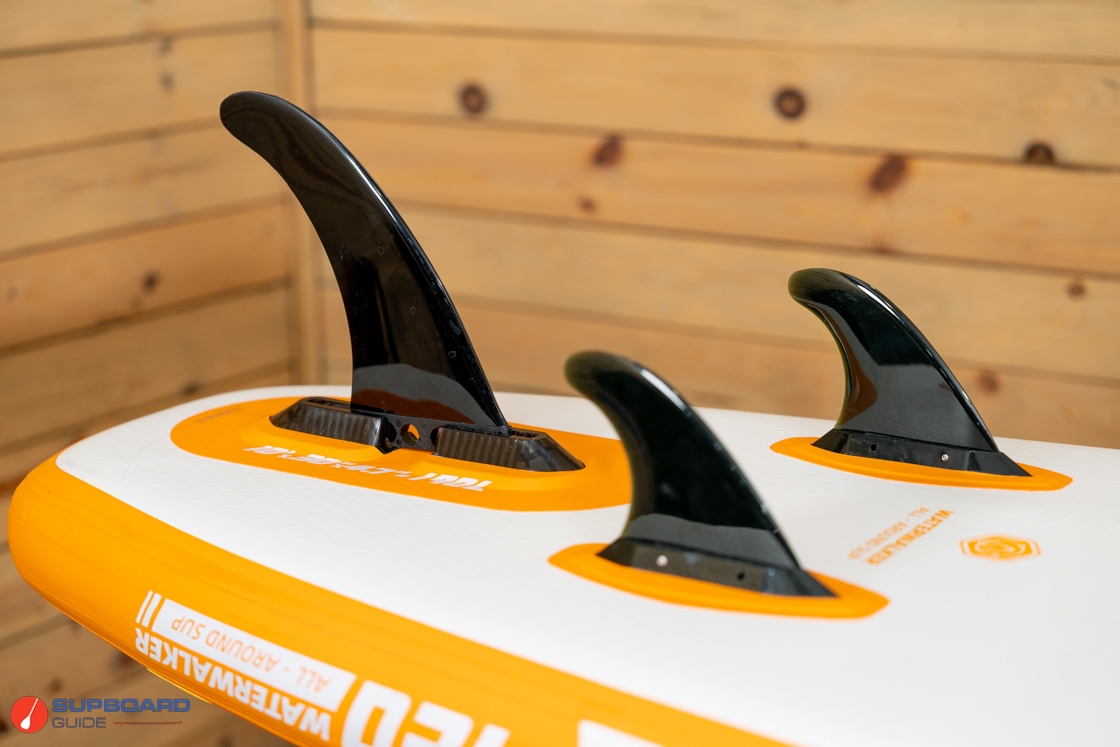
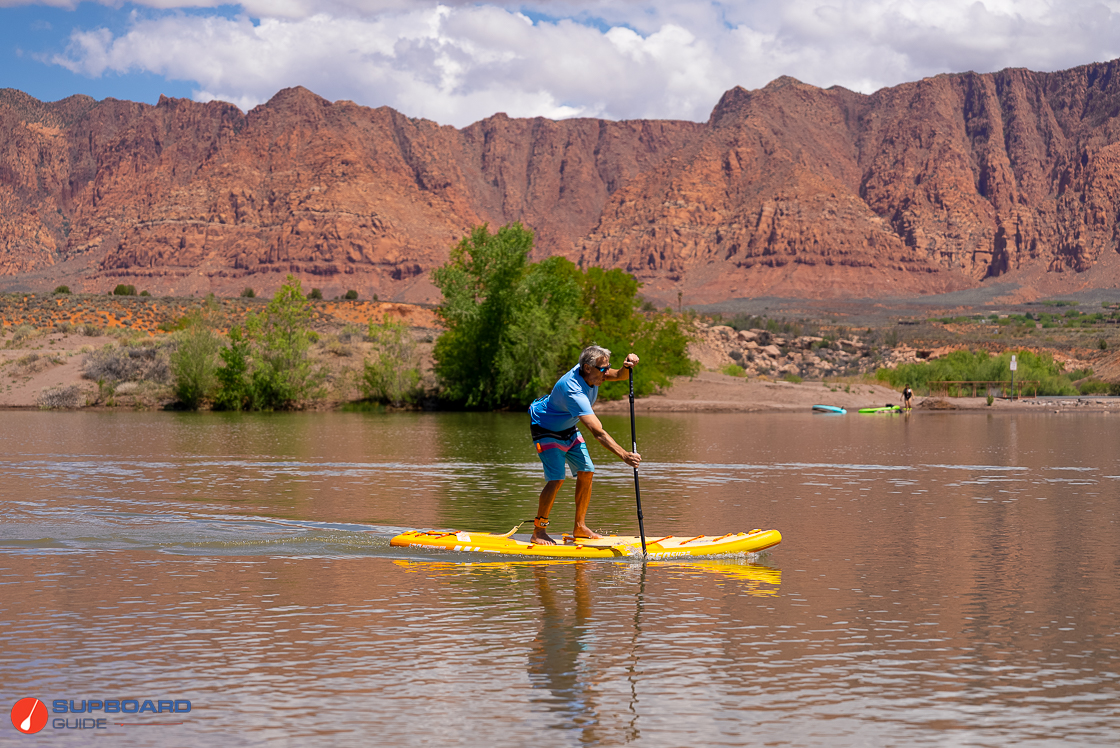
The Thurso Surf Waterwalker 120 tracks surprisingly well for its size. Yes, it’s short, but it’s also relatively narrow, and narrower boards generally do track better anyway as they are more ‘torpedo like’ in their progress through the water. The Waterwalker 120 also benefits from that long straight section in the plan shape, as those parallel sides lock the board onto its course.
The three fins on the tail also help keep the board on track. While they’re fairly flexy, they’re big enough to give a significant contribution to the tracking. (We tested this by trying the board without the side fins, and then just with the side fins. In each case the tracking was significantly reduced.) Overall, the board gets a deservedly high score for tracking in comparison to other boards of this general size.
Maneuverability: 9.6/10
Maneuverability scores are based on comparative performance to boards of a similar general length and style. In the case of the Thurso Surf Waterwalker 120 the scores compare to other boards in the 10’0 – 11’6 all-purpose/touring category.
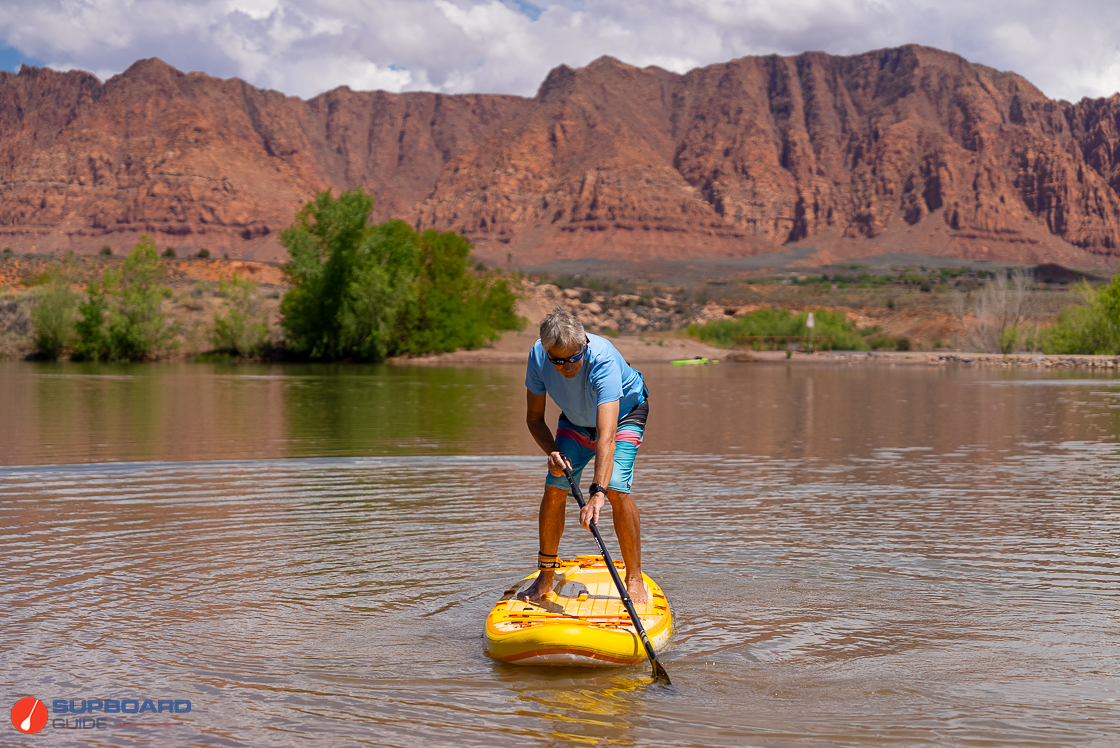
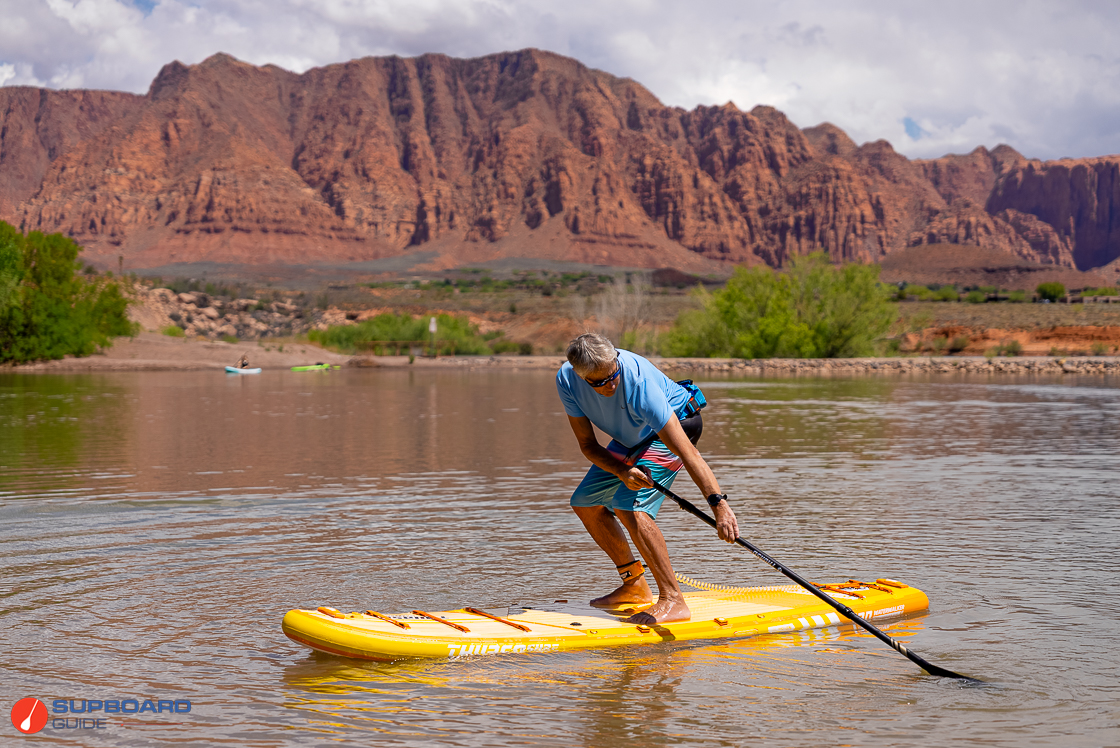
This is definitely a top scoring area for the Thurso Surf Waterwalker 120, largely because it’s so small. There’s not a lot of board to move around, plus which it’s impressively light too, so it’s just plain easy to change course on. While the tracking is good, when you ask it to turn it will, with alacrity! It’ll respond to pretty much any style of turning stroke, from simple sweep strokes through to full-power crossbow turns. (To understand more about turning styles and how to do them, check out our how-to video)
If you really want to have some fun with the turning, take the center fin out. You can now spin that board super easily. If you are looking for a board to get into some small surf on, then learning to really throw it around with super quick turns in this mode is a great way to get some practice.
Indeed, we want to make a specific plea to Thurso Surf on this topic. The Waterwalker 120 is potentially a great little learn-to-surf iSUP – if only those side fins were closer to the edges. As it is, they’re simply too close to the center to be of any use in a surfing context. Move them out a bit, and this board would offer a whole new performance dimension. We’d love to catch some waves on it!
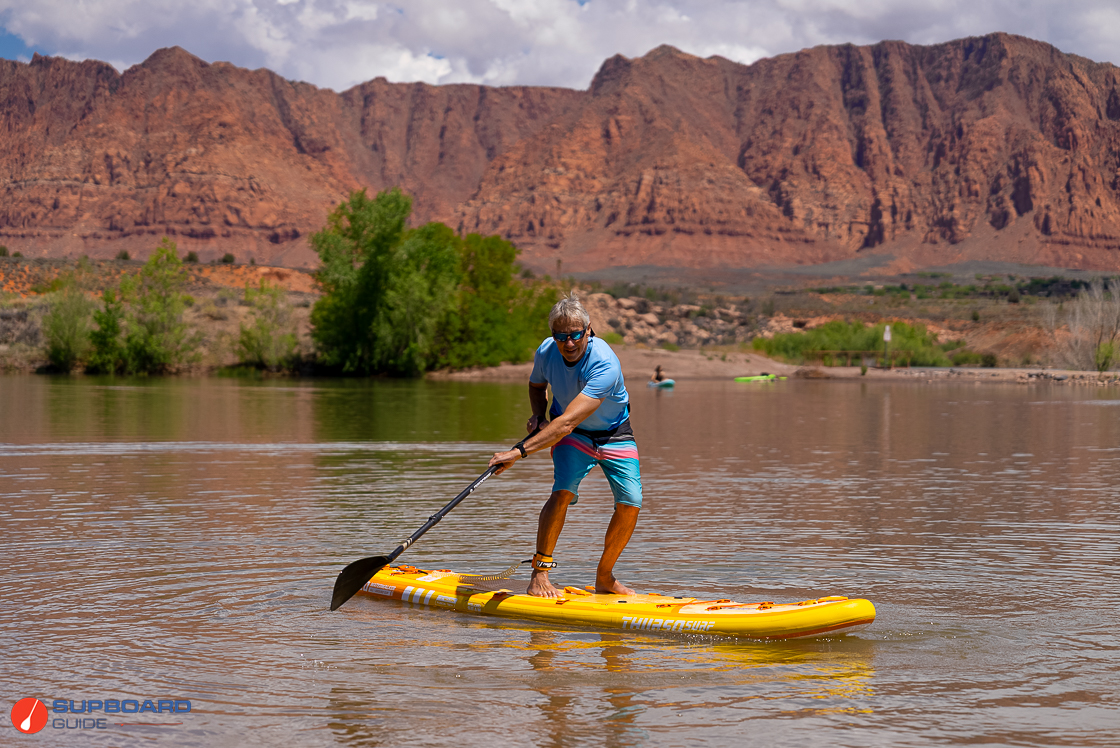

Construction Quality: 9.5/10

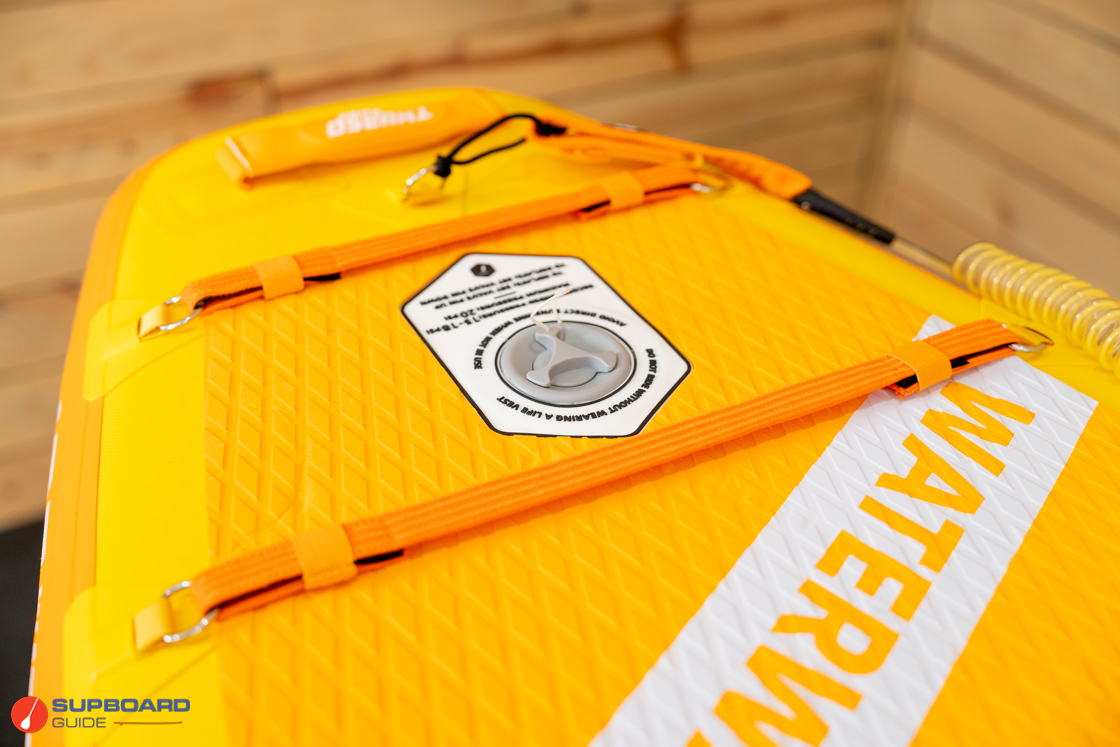
The Waterwalker range has been Thurso’s mainstay all-round paddleboards for several years now. While the shape of the Waterwalker 120 remains essentially unchanged, the construction now features welded seams, which is a major change from the carbon-reinforced glued rails used before. Plus of course, we’ve had that major change in thickness, from 6” to 4.7”.
Inside the board
Thurso Surf now uses woven dropstitch inside the Waterwalkers, which helps reduce weight and increase rigidity. While the Waterwalker 120 is quoted at 4.7”, we found it to actually be more like 5” thick. However, we find this with most boards quoted at 4.7”, and the main point is that, whether it’s 4.7 or 5”, it’s still significantly less thick than 6”, enough to make a major difference to both stability and performance on a board of this size.
Top and Bottom Skin
The outer skin of the Thurso Waterwalker 120 utilises dual layer fusion construction, with two sheets of PVC fused together onto the dropstitch substrate. This fusion process is light yet strong, and widely regarded as the leading construction in iSUP board manufacture.
Side Construction
Thurso Surf have upgraded the rails of the Waterwalker range by introducing welded seams. The side panel is now heat welded as well as glued to the top and bottom layers, adding extra integrity to the construction. A further layer of PVC is then added and the top and bottom edges of the rail are then fortified with an additional PVC lape layer.
Overall
Thurso played a smart game here. Switching to a thinner dropstitch core will always make a board slightly less stiff. However, welded rails (if done properly) do appear to increase the structural integrity of a board and give it a more rigid feel. Overall, there’s no doubt that Thurso have got away with it, and the end result is a board that still holds together well, but feels a whole lot more fun and playful, plus a little bit lighter too!
Board Stiffness 1.4” Bend
We were pleasantly surprised by this result; we were expecting to see a little more flex from the Waterwalker 120 when we subjected it to our bend test. Reducing the thickness from 6” to 4.7” inevitably reduces the stiffness of a board, especially when it’s also relatively narrow. Yet the welded rails have clearly played a part in keeping the flex to respectable levels.
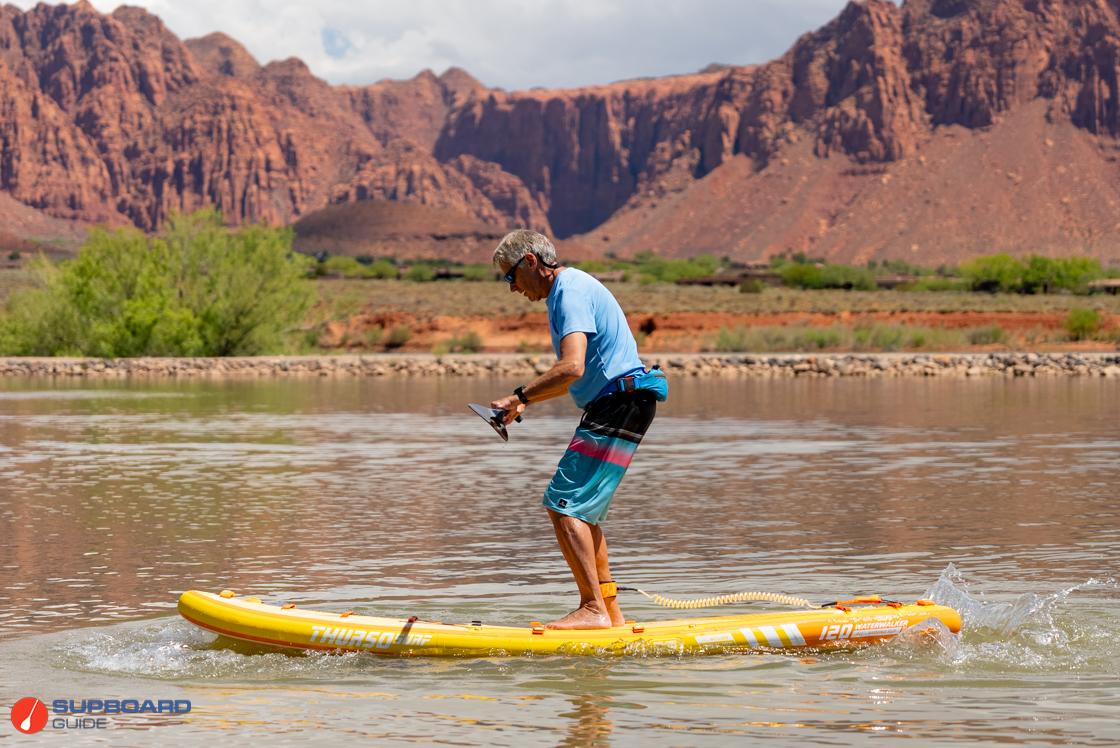
On the water, heavier riders will for sure feel a bit of flex if they move around on the board. However, it should be borne in mind also that our bend test involves putting the board under a 150 lb load, which is actually the maximum rider weight recommended by Thurso Surf. Lighter riders will experience significantly less distortion.
To ascertain the rigidity of each board we review, we have been using our own specific laboratory bend test process since 2021. The board is inflated to its maximum recommended PSI and positioned exactly on our measuring jig. 150lb weight is then applied to the standing area to see how much bend it causes. While this isn’t an exact replication of the weight distortion that occurs when a rider stands on a SUP board in the water, it still gives a very useful comparative tool in determining the relative stiffness of the various board construction processes.
Features/Accessory Review: [9.4/10]
Features:

The Thurso Surf Waterwalker 120 comes in a choice of two colorways, turquoise as shown above, or the tangerine color scheme shown below. We really liked the bright vivacious feel that these cheerful colors gave the board, matching its general character on the water. In both color schemes the nose area of the board retains that wood finish look on the PVC, which is also really classy and pleasing to the eye.
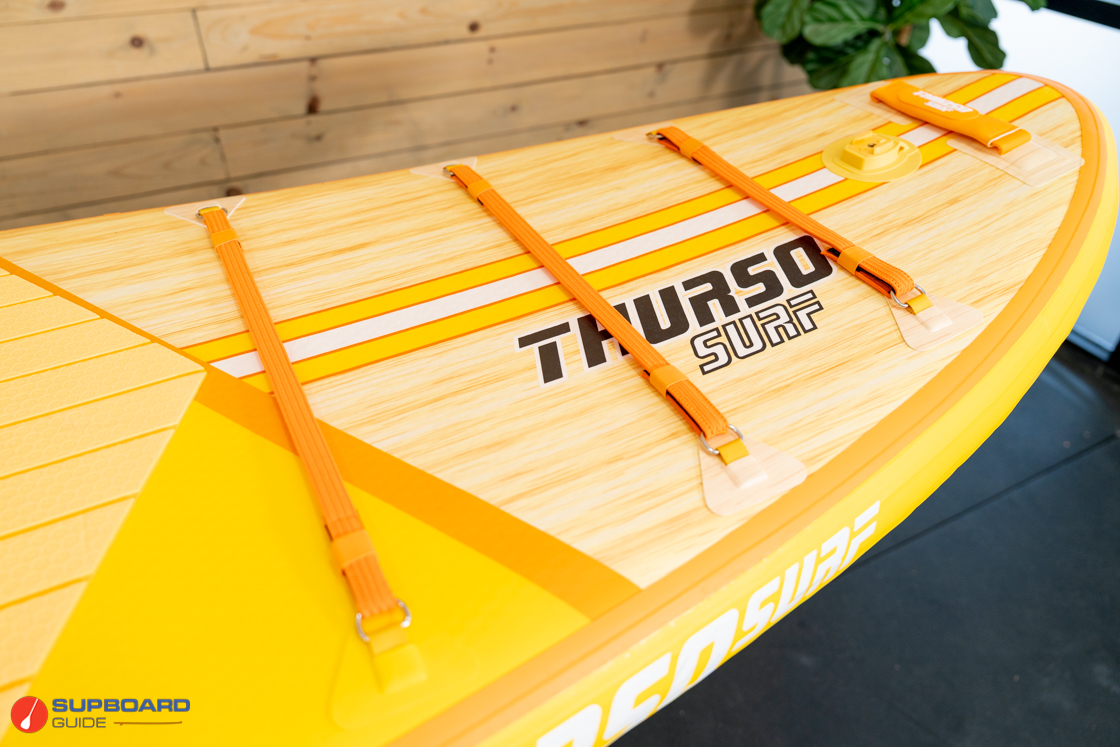
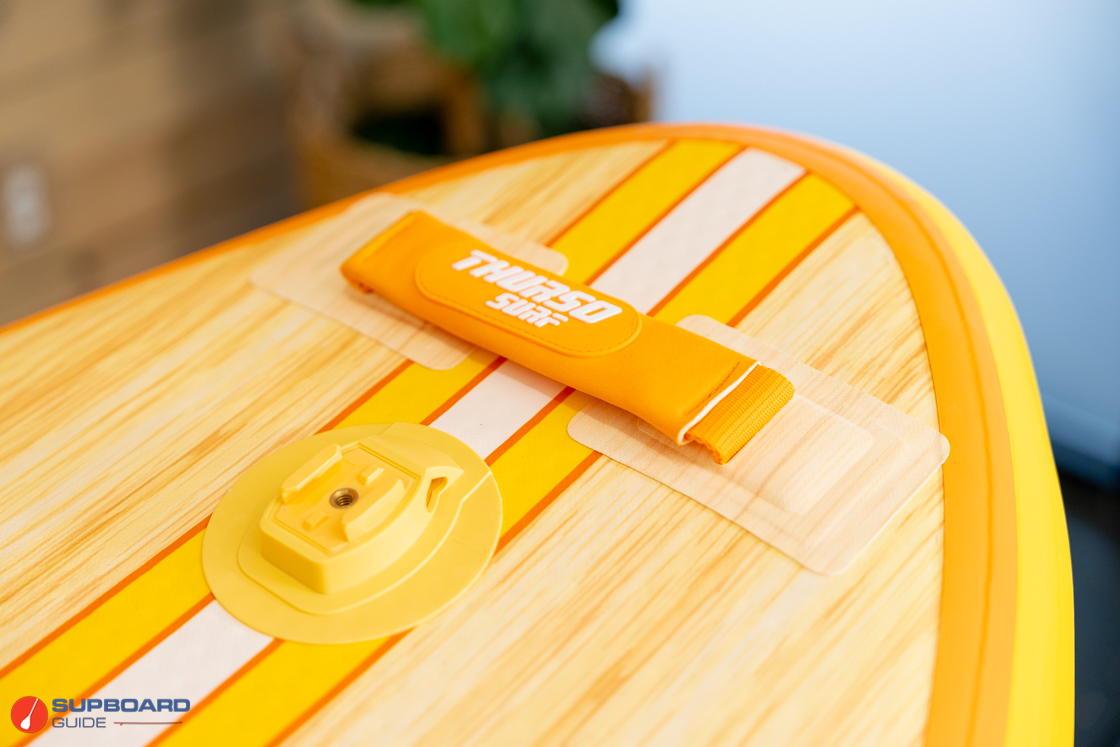
The deckpad on the Thurso Surf Waterwalker 120 is EVA foam, embossed with tiny Thurso logos to create the textured grip surface. It works well, although we did find just occasionally when the deck was extremely wet that the grip could be slightly slippery with bare feet.
So let’s now take a look at the fittings and fixtures on the deck of the Waterwalker 120. Starting at the nose, we find a comfortable carrying handle and an action camera mount of the multi-fitting style, that can either take a slide-in GoPro mount or anything that screws into an M8 Thread.
Next up we have three cargo straps, which are good quality but quite stretchy so they’re a bit difficult to get a lot of tension on, and they are also positioned quite far apart. So they would be good for clothing or popping a dry bag under, but less suited for holding a waterbottle or pair of beach shoes.
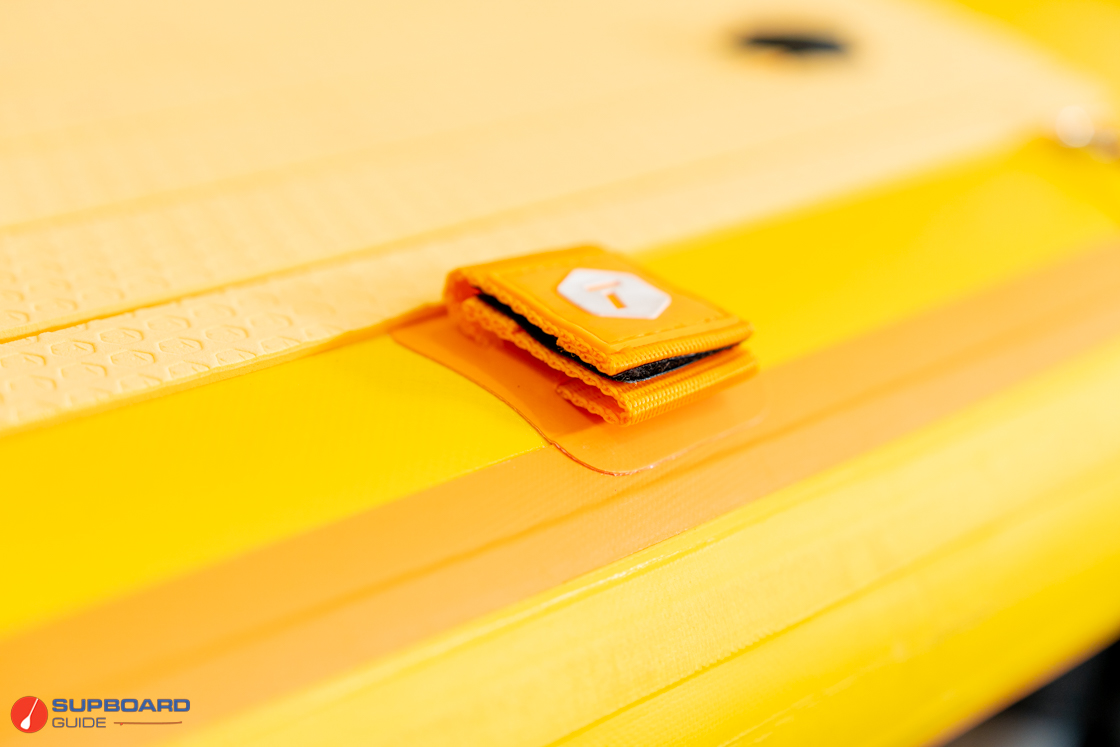
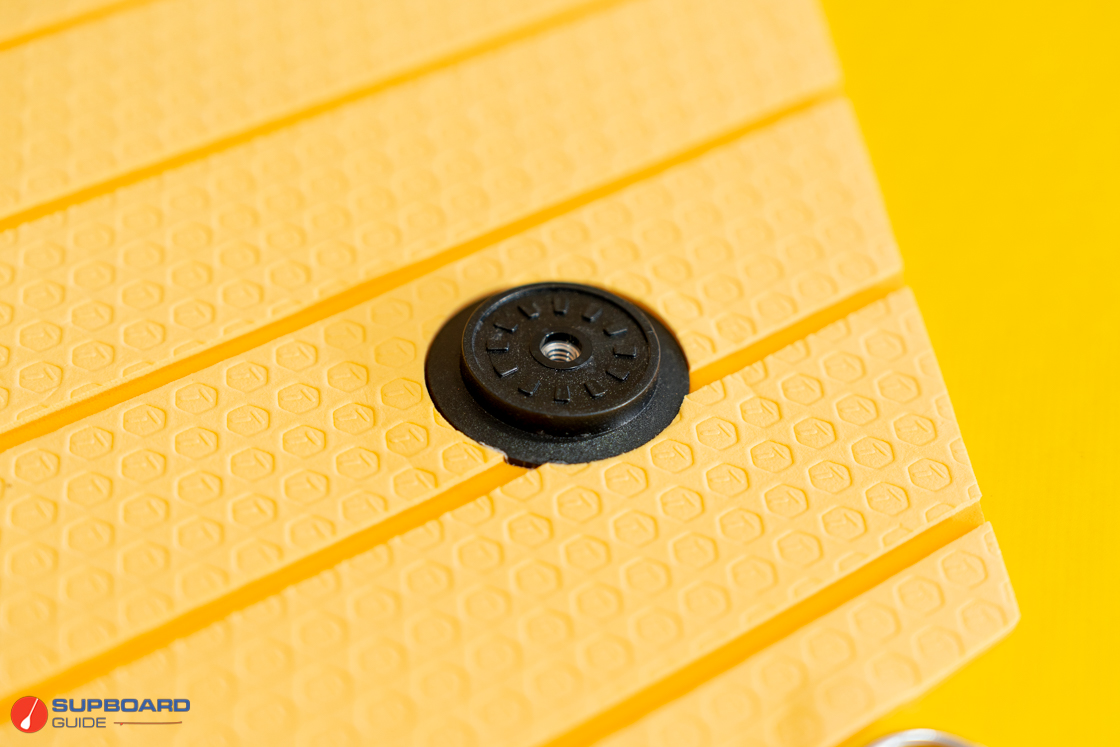
Next up we have a set of 4 solid D rings for securing a kayak seat, which realistically might be a little on the tippy side on such a small board for most adults of average weight or greater, but is a fun option for smaller people. At the front end of the deckpad there are a couple more action camera mounts of the screw-in variety, one each side, and then we have a pair of paddle holder straps on each side.
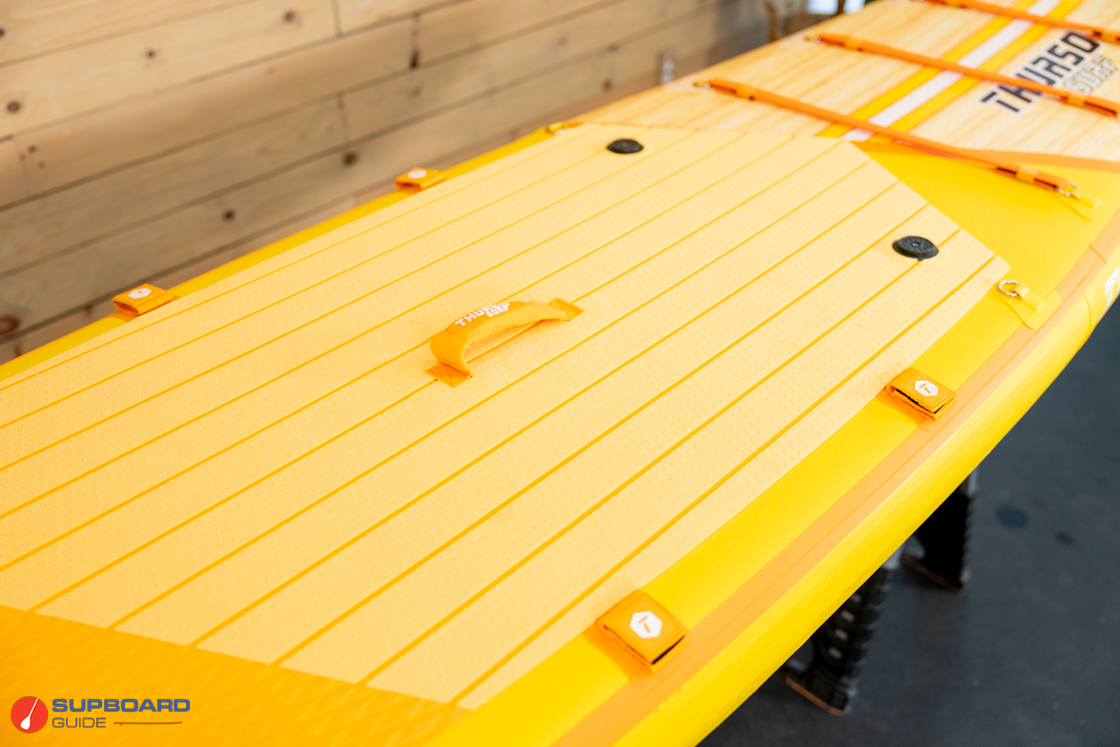
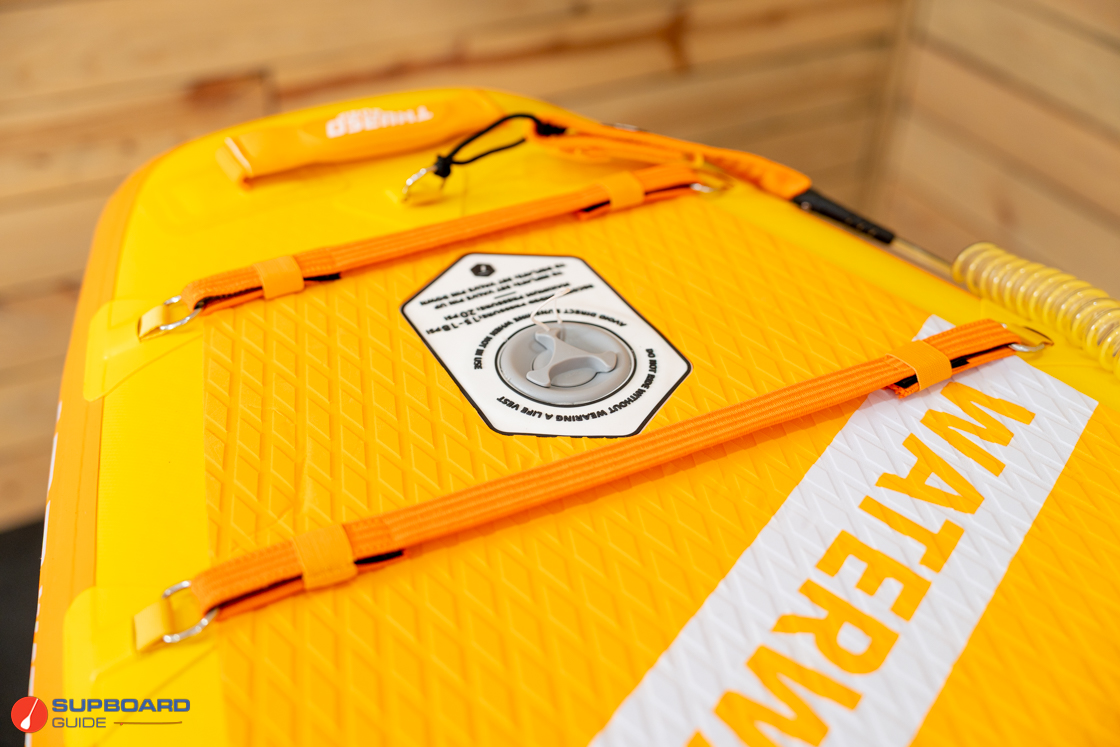
Behind the main standing area is a large expanse of uncluttered deck space, and finally two more bungee straps right back on the tail. These are perhaps a bit too far back for any sort of serious cargo carrying, but may still come in useful. Finally, at the very rear of the board we find the leash fixing point and a nicely padded carrying handle. All in all it’s an excellent set of fittings for a relatively small board; full marks to Thurso for not falling into the trap that so many other brands do, whereby smaller boards tend to be less feature-rich for some reason, as if smaller people need to carry less things!?
The one minor omission is as we discussed in the maneuverability section, this board actually has great potential for a bit of small wave action, and as such would have benefited from a stomp pad on the tail.
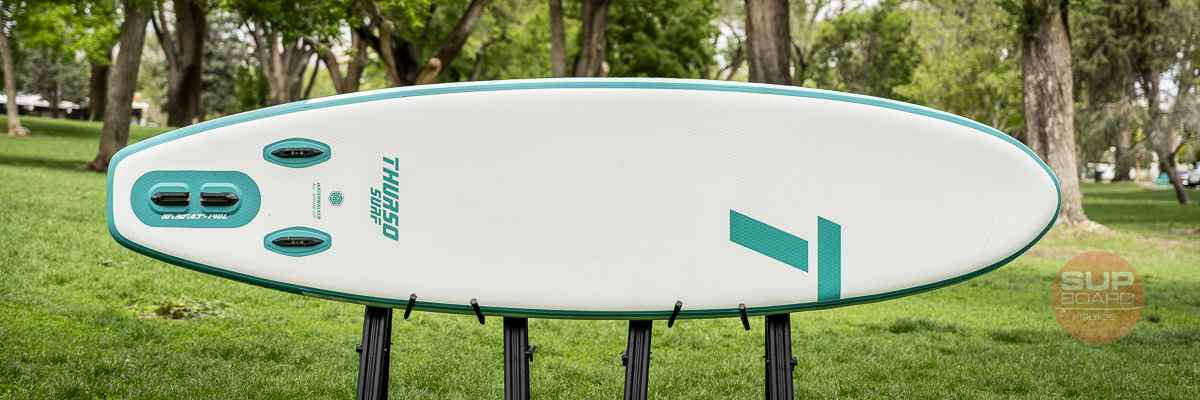
On the underside of the board the Waterwalker 120 has the standard Thurso fin set up, with a central split-style US Finbox, and two thruster fins mounted unusually close to the center line. As per the previous comments about the potential of this board for a bit of surfing, we’d love to see Thurso move those side fin boxes out much closer to the rail, which would hugely enhance what the board has to offer in this respect.
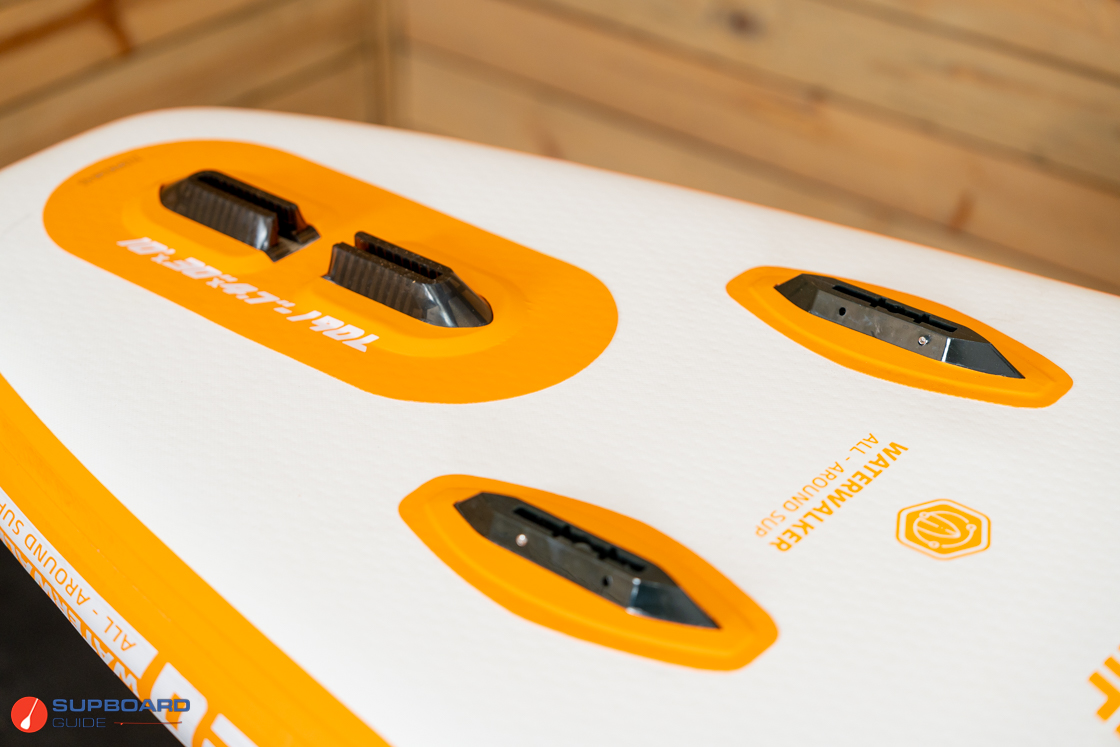
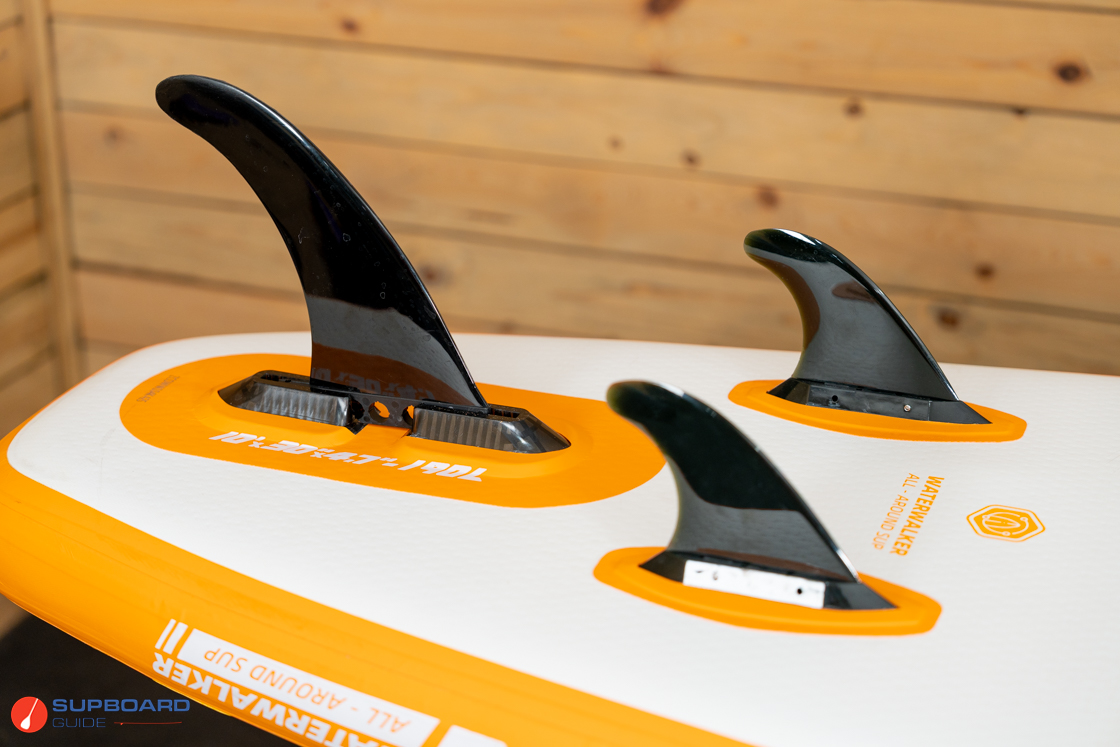
The rear center fin uses a split US fin box, and the fin is supplied with a finbolt but can also be configured with up to three click-in tensioners, so that the fin can just be pushed-and-clicked into position rather than using the nut and bolt to hold it in. While this system works well in theory, the center fin is extremely soft and thus quite hard to get good purchase on to actually push into position, so it wasn’t the easiest to use this way.
The two side finboxes are of the FCS style – the fin is inserted into the box, clicked back into position and then the allen bolts are tightened with the allen key supplied. It’s a little bit fiddly, but in general you can actually probably get away without tightening the bolts, the sidefin tends to stay in as long as you’ve properly clicked it back into its correct position.
A big shout-out to Thurso Surf for the extremely nice accessory carry case that their boards now come with, with separate pockets for the fins, bolts, allen keys, repair kit items and the other various bits and pieces. It’s a nice touch that makes it easy to keep everything together and allows you to check at a glance that you do actually have everything before heading off to the beach, rather than having to root around in the bottom of the bag or check separate pockets, as is the usual situation.
Included Accessories:
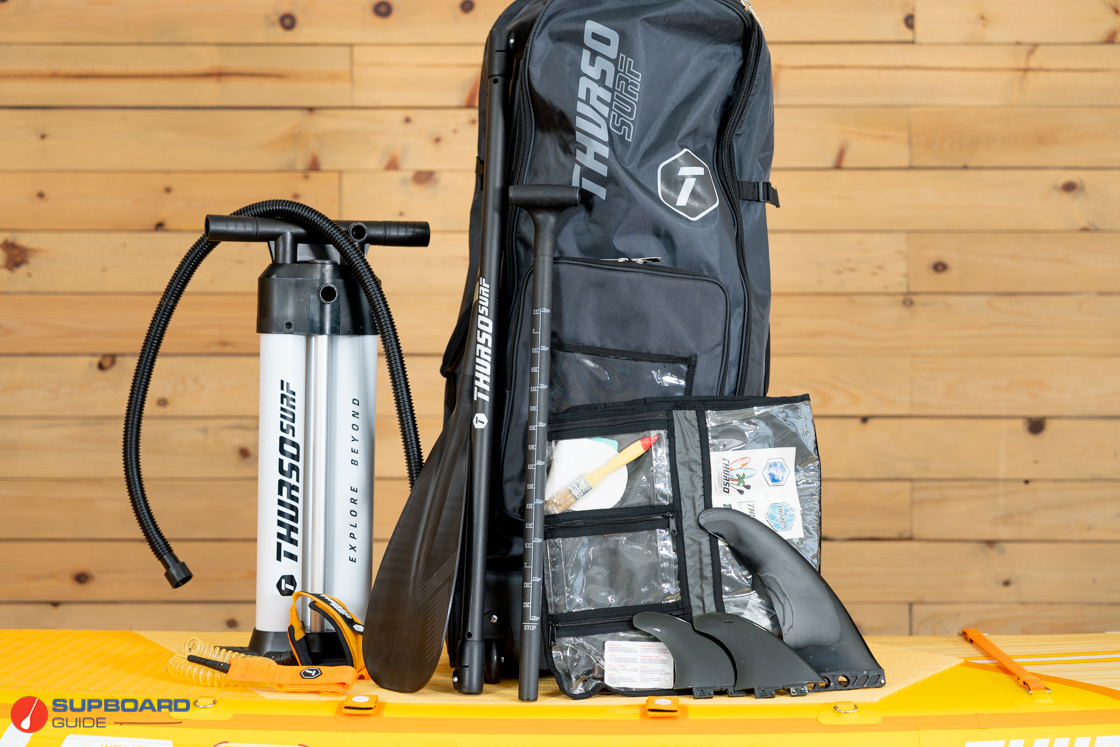
The Thurso Surf Waterwalker 120 can be purchased board only (including leash and fin kit), or as a package with the option of including any or all of the following accessories; the backpack, a rechargeable electric pump, life jacket, kayak seat, SUP carrier strap, and the Thurso Surf Carbon Hybrid 3 piece adjustable paddle. We really like the attention to detail whereby the leash color matches the chosen board color scheme.
Purchasing the accessories as part of the bundle is a smart move as the prices are typically around 20% cheaper than buying them individually. It’s all good quality equipment too; the electric pump is reasonably powerful, and takes about 8 minutes to inflate the board. The backpack is spacious and has rucksack straps and wheels. The Carbon Hybrid paddle is a reasonably good beginner/intermediate paddle, but it would be great if Thurso could also offer the bundling option of their higher performance paddle options too, because the smaller rider who would typically be attracted to the Waterwalker 120 would most definitely benefit from a higher performance paddle, such as the Carbon Elite paddle.
Summary Review of the Thurso Surf Waterwalker 120
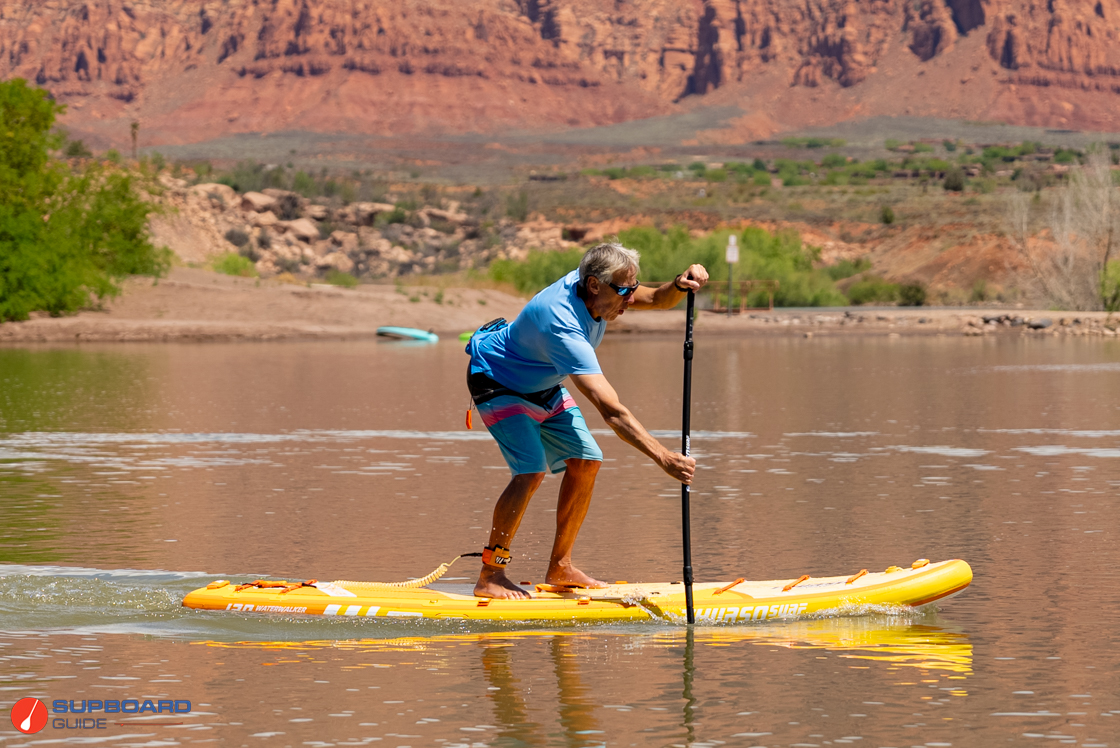
As we said at the start of this review, there aren’t too many options when it comes to small all-round boards. This in itself would give the Thurso Waterwalker 120 a better chance of standing out in the crowd, but honestly, this board would still be a stand-out however crowded the market. The move to 4.7” dropstitch and welded rails has improved the board’s performance quite considerably. When you add these new factors into the already successful combination of an intelligent plan shape offering good stability for its size and a really good set of fittings and fixtures, it all comes together to create a really excellent package.
For smaller paddlers wanting an all round board or middleweight paddlers wanting something smaller, the Waterwalker 120 is most definitely a top recommendation. Nice one Thurso Surf!
Happy paddling! We hope you enjoyed this review of the Thurso Surf Waterwalker 120. If you have any questions or comments please leave us a comment below!
Bill Dawes
Latest posts by Bill Dawes (see all)
- Thurso Waterwalker 132-12 iSUP Review – 2025 - June 18, 2025
- Red Paddle Co 11’3 Sport MSL 800 iSUP Review – 2025 - June 17, 2025
- Red Paddle Co Ride 11’6 iSUP Review – 2025 - June 16, 2025


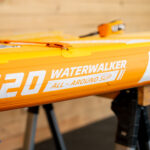




Hi Justin,
A big thanks to you and your team for the amazing tests and reviews for this paddle board and many others. I saw on your iRocker Q&A where many people have asked you to recommend between the WaterWalker and iRocker …but usually you emailed them directly so the rest of us couldn’t read 😉 Anyhow, we have similar questions and hope that you can help us make our decision. We have a friend with the WaterWalker 126 so we have tried it many times this summer and love it. I like the 3 fins on the WaterWalker but appreciate the electric pump that comes with the iRocker. We also like the wheels on the Thurso bag for travelling ease.
My husband and I are beginners at paddle boarding but we often ski in the winter and kayak in the summer. We both are petite people (height less than 5”6 and weight less than 130lbs) so we are looking at smaller boards such as the WaterWalker 120, the iRocker all-around 10, and iRocker Cruiser Ultra 10.6. We are looking for a good balance among carrying weight, stability, and manoeuvrability, especially as we get older and lose our balance and strength. We hope to travel around North America as well as the world and kayak as much as possible. Our plan is mostly to solo kayak on lakes, rivers and hopefully explore seashores eventually, with the occasional kneeling and standing up on our own board. Periodically our children and friends may paddle in tandem on pretty smooth waters. We are older and hope to use these boards for at least 10 years with about 10-15X/year usage, well into our retirement when our balance will decrease. Should we stick with these smaller boards, as we will mostly use them for kayaking? Is kayaking easier and faster with the narrower WaterWalker 120?
All the boards (WaterWalker 120, Rocker all-around 10, and iRocker Cruiser Ultra 10.6) seem very well made but the WaterWalker has the additional carbon sidings. Which board should we get, especially in terms of durability?
Thank you so much in advance.
Hi Christine,
Thurso boards are exceptionally durable; they’ve hold up extremely well for us and we’re definitely not gentle on them. My only suggestion would be to maybe consider the Water Walker 126 if you’ll occasionally be bringing kids or passengers along – it’ll just give you a little extra volume but won’t take away any maneuverability.